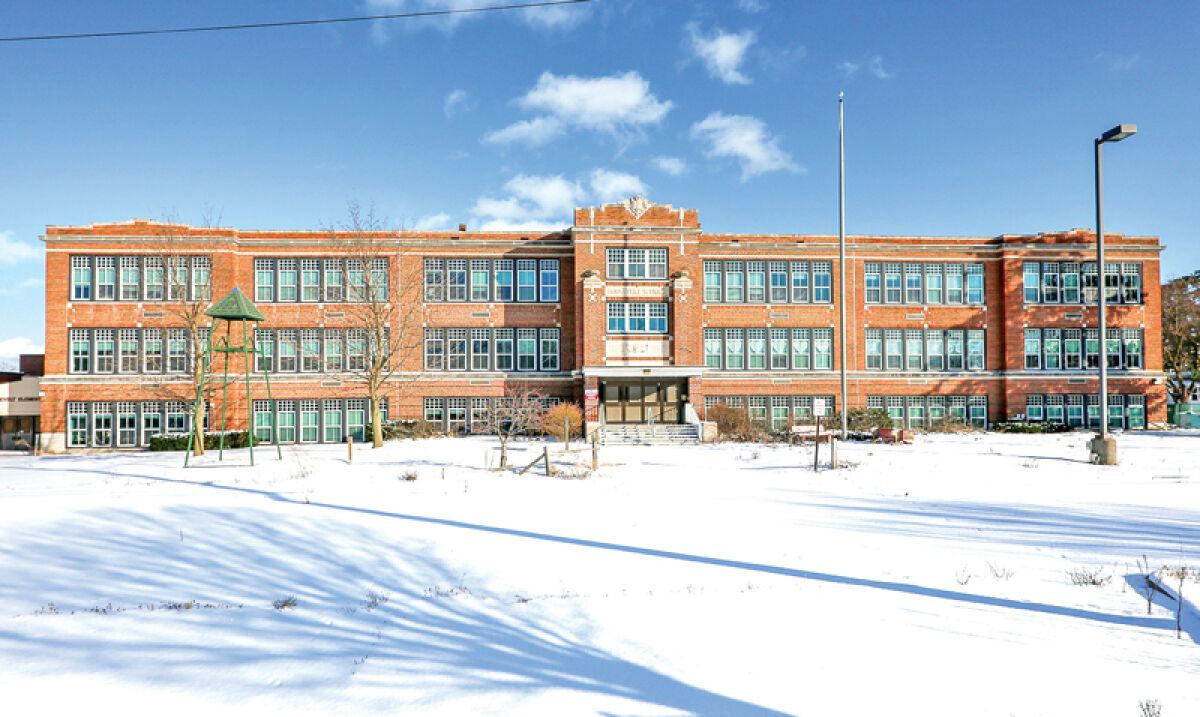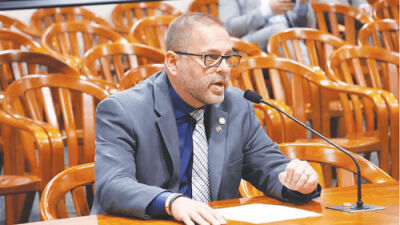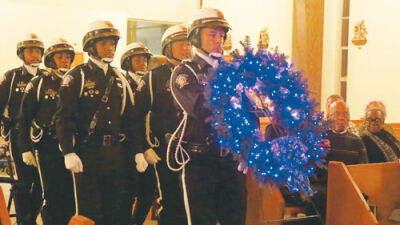KEEGO HARBOR/WEST BLOOMFIELD — The fight over Roosevelt Elementary continues.
Located at 2065 Cass Lake Road in Keego Harbor, and part of the West Bloomfield School District, Roosevelt Elementary served the district for more than 100 years before closing in 2022, making it the longest continuously operating school building in Oakland County.
In 2023, the school board voted, 5-2, to demolish the building and its playground. The district’s stance is that the building is a liability in its current form — dangerous, falling apart, costly to maintain — but the land it sits upon is prime real estate, which the district could redevelop in the future.
However, since the vote, there has been pushback from some members of the community who feel that the building should be preserved or repurposed for aesthetic, historical and cultural reasons. They also have concerns about demolishing a building that may contain toxic materials.
They mobilized as Heart of the Lakes Community Inc., a nonprofit organization, and filed an injunction in Oakland County Circuit Court. When a permanent injunction was denied, HOTL filed for an emergency motion for stay, pending appeal. Now, lawyers on both sides are gearing up for a hearing next month before the Michigan Court of Appeals.
In the meantime, HOTL will be hosting a forum titled “Transparency: The Truth About Roosevelt and Your Tax Dollars,” set for 6:30-8:30 p.m. Wednesday, Jan. 22 at the West Bloomfield Township Public Library, located at 4600 Walnut Lake Road in West Bloomfield Township.
The event bills itself as focusing on “your tax dollars, environmental risks, fiscal responsibility, historic preservation and the legal status of our case,” exploring everything from the potential costs and environmental impacts of demolishing Roosevelt, to the school’s value as a historic landmark, and why the lawsuit to save it has taken on new urgency.
Derek Howard, an attorney with Doerr Mac Williams Howard PLLC, will provide an update on the case, while Joe Novitsky — an architect who worked on the design of The Ivy Lofts in Berkley — will explore the potential of repurposing historic buildings such as Roosevelt. Novitsky has made a $1.7 million offer to preserve the school, which was rejected by the district.
Also speaking in support of the effort will be Kristen Nelson and Bob Hoffman, both members of the Oakland County Board of Commissioners, and Devan Anderson, an architect who serves as both president of the board of directors for Preservation Detroit, and as secretary for the board of directors for the Michigan Historic Preservation Network.
At press time, organizers said that additional speakers were also being lined up. It all comes in advance of the Michigan Court of Appeals hearing the case at 10 a.m. Wednesday, Feb. 5 at the Detroit Courtroom — Cadillac Place, on the 14th floor, at 3020 West Grand Boulevard in Detroit. Organizers with HOTL encourage members of the public to attend and show their support.
Tim Mullins, the attorney representing the school district, said that the Board of Education has good reason to tear down Roosevelt and keep the land rather than selling it. He said the decision was made after many public meetings and study sessions, as well as abundant publicity.
“(Roosevelt) is an old decrepit building, multi-storied with no handi-capped access, costing us $8,000 a month maintaining it and securing it, and there’s been two fires, and all kinds of problems — a wasting asset, a liability to the district and community that doesn’t serve any productive purpose. But the land does (have a purpose),” Mullins said. “We have a school board, elected by the people, who have a long-term plan. If 10 years from now, when the economy picks up and maybe we get our population growing again in Michigan, you will see even more growth in this area. And the long-term plan would be, when the need arises, to have that land ready to serve an educational purpose again. We own that piece of land — it’s available to us. It’s beautifully located, and they’re not just going to give it away. We haven’t entertained any offers because we’re not selling it.”
He also cast doubt on the intention of the people trying to save Roosevelt.
“They’re very wealthy people — business people,” Mullins said. “This is a very valuable piece of property, and they want to buy it out from taxpayers. If there really were that many people who supported them, they’d be on the school board right now — we just had an election this fall, so why didn’t they try to take over the board? You basically have a few wealthy businessmen making a lot of noise buying up advertising and paying attorneys to try and snatch this land from under taxpayers.”
In a series of emails, supporters with HOTL shared their thoughts on the situation.
Jennifer Vasquez, HOTL’s founder and president, said one key concern is the public’s health. She pointed to guidance by the Consumer Product Safety Commission that says the best thing to do with asbestos material in good condition is to leave it alone. The contracted demolition for Roosevelt would be a wet demolition, where water is sprayed on the collapsing structure to make the particles heavy so that they settle down rather than staying in the air.
“This means very little to me,” Vasquez said. “You cannot flush a toilet without the toxic plume of invisible contents coming back out, and that is all wet!”
She said that rather than destroying the century-old building and risking the release of hazardous materials, Roosevelt should instead be repurposed to bring revenue to Keego Harbor and Oakland County. She sees potential in converting the structure into affordable housing, lofts, shops, gardens, a community center and more.
“The possibilities are endless, and the easement to convey that property for community use is already included in the deed conveyance from way back in the 1900s,” Vasquez said. “This could have been a celebratory event for Keego Harbor. Instead, there was undeserving desire by WSBD to demolish Roosevelt, long before the voting took place.”
David Emerling, another advocate for saving Roosevelt, said the historic building is part of what gives Keego Harbor its charm.
“The people that live in Keego Harbor view Roosevelt as the heart of our walkable town,” David Emerling said. “What makes us passionate about saving Roosevelt is once these historic buildings are torn down, they are lost forever.”
He said that instead of accepting offers to repurpose the building, the district “would like to spend our taxpayers’ money to knock it down without taking all the correct precautions to do it safely,” adding that “not one of the people that voted to destroy our historic school live in Keego Harbor,” and “the taxpayers own this building — they are the very people that are passionate about saving it.”
His wife, Susan Emerling, echoed this sentiment.
“When the district announced at a public meeting that it would be demolished, I surprised myself by jumping up and saying, ‘I will chain myself to that building before I allow a bulldozer near it!’ I was far from alone — so many people have joined together in the fight to save that building,” said Susan Emerling. “Historic buildings can be repurposed in a way that saves energy, resources, and minimizes environmental hazards with careful abatement and encapsulation procedures. While I am truly sentimental about the beautiful building, the environmental issues for me are also upsetting.”
Christian Sonneville is another advocate for saving Roosevelt. He is a structural engineer with 35 years of experience as a property insurance company executive. He said he studied a report detailing a June 2, 2022 incident in which part of the plaster ceiling collapsed over Room No. 204, which in turn led to the district’s decision to close the school. He said the district failed to comply with the recommendations of insurance company engineering experts.
“(The district) failed to clean up the debris, repair the collapsed ceiling and reinforce similar ceilings with modern screw nails, a standard and inexpensive practice,” Sonneville said.
In response, Mullins said he feels the incident and extent of work to be done actually illustrates why the building should no longer stand.
“You can spend a whole lot of money trying to keep people in that building, or you can recognize that the building is way past its operational lifespan as a modern educational facility,” Mullins said. “It’s not safe for any use in its present state. To repurpose, you’d have to do all the asbestos abatement and basically tear the entire building down and rebuild, anyway.”
 Publication select ▼
Publication select ▼






















